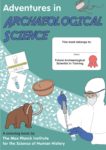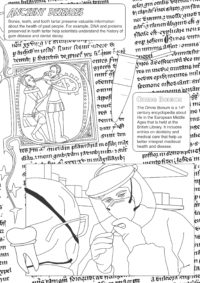 Look no further. Scientists at the Max Planck Institute for the Science of Human History (MPI-SHH) have solved all your Bad Santa problems by creating a short but extremely sweet coloring book about archaeology for all the kids out there with visions of skeletal remains and radiocarbon analysis dancing in their head. (Don’t even pretend you weren’t one. In fact, don’t even pretend you aren’t still one.) The best part is you can get it online for free, which means you don’t even have to order it to get it. You just click on this link (pdf) and print that bad boy up.
Look no further. Scientists at the Max Planck Institute for the Science of Human History (MPI-SHH) have solved all your Bad Santa problems by creating a short but extremely sweet coloring book about archaeology for all the kids out there with visions of skeletal remains and radiocarbon analysis dancing in their head. (Don’t even pretend you weren’t one. In fact, don’t even pretend you aren’t still one.) The best part is you can get it online for free, which means you don’t even have to order it to get it. You just click on this link (pdf) and print that bad boy up.
It’s called Adventures in Archaeological Science Coloring Book and it’s just as adorably serious as it sounds. It manages to touch on some of the most important scientific techniques in use in archaeology today: the study of dental calculus to map an individual’s diet and health, DNA analysis, radiocarbon dating, analyzing microscopic food residue on the inside of pottery, stable isotope analysis and more. The issues are addressed succinctly in a few lines accompanying eminently colorable line drawings of ancient figures, animals and scientists in full gear. Actually now that I think about it that poses a significant challenge, color-wise. You’d either wear out the white pencils or throw caution to the winds and go psychedelic.
 The project started out as an adjunct to a workshop on scientific illustration run by Christina Warinner and Jessica Hendy at the MPI-SHH. It has been a popular course for several years running, so when the Institute was pondering events for Germany’s public outreach evening, the Long Night of Science, Warinner had the idea to enlist her students to make a coloring book that illustrated the science of archaeology. Then, as Warriner and Hendy were adding the text and editing the final version, they realized they wanted it to have as wide a reach as possible. Enter crowdsourcing.
The project started out as an adjunct to a workshop on scientific illustration run by Christina Warinner and Jessica Hendy at the MPI-SHH. It has been a popular course for several years running, so when the Institute was pondering events for Germany’s public outreach evening, the Long Night of Science, Warinner had the idea to enlist her students to make a coloring book that illustrated the science of archaeology. Then, as Warriner and Hendy were adding the text and editing the final version, they realized they wanted it to have as wide a reach as possible. Enter crowdsourcing.
As we were making the final touches to the coloring book, we realized that it would be a shame to have it only accessible to English and German-speaking children. Human history belongs to all of us, and the research and discoveries we feature in the book have taken place all over the world. We thought – wouldn’t it be great if we could share this information with children everywhere – in their own native language – so that they too could experience the joy and excitement of science and archaeology? Wouldn’t it be amazing if we could bring this book with us to our field projects so that we could explain to local children what we are doing and what the world learns by studying people from the past? And most importantly, what if we could show these children that they too could be part of this process and inspire a future generation of archaeological scientists around the globe?
One of the best things about being at an institute like the MPI-SHH is that our researchers come from all over the world. I’ve lost count of how many nationalities are represented among our students and staff, but it is more than twenty, and together we work in dozens of countries on every continent. As the coloring book was nearing completion, we asked for volunteer translators and we were absolutely overwhelmed by the response – with immediate offers for Spanish, Chinese, Arabic, Croatian, Finnish, and Swedish, among others. After posting the coloring book to Facebook, we had many more offers from archaeologist colleagues and collaborators, and we now have translations underway for Hindi, Turkish, Italian, Greek, Ukranian, and Hebrew. And we’ve also reached out to the communities where we conduct fieldwork, and we will soon have translations in Nahuatl, Yucatec Mayan, Nepali, Mongolian, and Tibetan.
One of the things I have loved about the translation process is that nearly every translation is being performed by an archaeologist or anthropologist who is a native speaker of that language. This means that in addition to learning about archaeological science, the children will be introduced to someone from their own language group who is participating in this research. We hope that this will help give the children tangible role models from their own countries and communities, and to help make this connection even more clear, we are adding “cartoonified” portraits of each translator to the back cover so that children can see them, look them up, and learn more about their work.
The coloring book is available in several of those languages already — English, Chinese, Spanish, German — with many more in the planning stages. Arabic, Dutch, Italian and Nahuatl are on the cusp of being released. Many more have been assigned translators. You can keep track of their progress here.